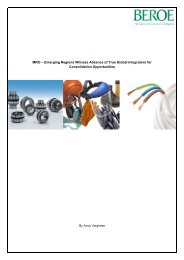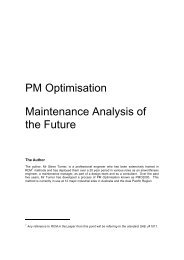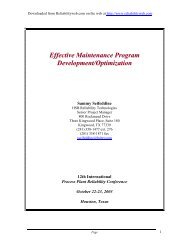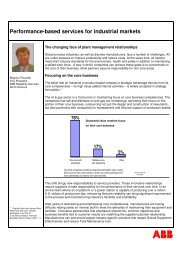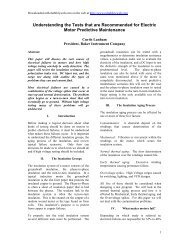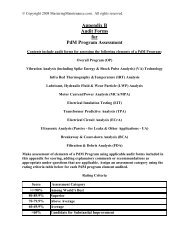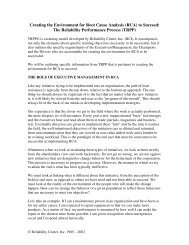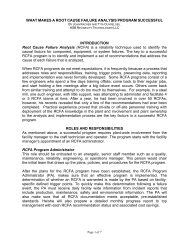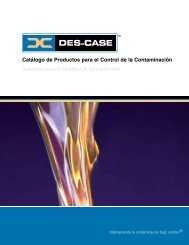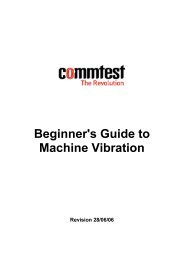Download the 2011 Edition (PDF) - ReliabilityWeb.com
Download the 2011 Edition (PDF) - ReliabilityWeb.com
Download the 2011 Edition (PDF) - ReliabilityWeb.com
You also want an ePaper? Increase the reach of your titles
YUMPU automatically turns print PDFs into web optimized ePapers that Google loves.
Big thoughts and small actions make a difference.<br />
Here’s what we’re working on and thinking about.<br />
What about you<br />
Feel free to share this… pass it along.<br />
T hings to think about (and do) this year.
FEATURING
ENGAGE<br />
Engage your staff with an open and objective mind to improve <strong>the</strong>ir<br />
morale and reliability. Be prepared to hear <strong>the</strong> unheard of, and to hold<br />
ideas until <strong>the</strong>y are ready to be acted upon. Provide feedback to staff so<br />
<strong>the</strong>y know <strong>the</strong> status of <strong>the</strong>ir ideas. Not all ideas can be taken, but too often<br />
we allow suggestions to go into a black hole, never to be formally responded to.<br />
Consider configuring an internal portal or social network of sorts to allow staff<br />
<strong>the</strong> freedom to both make suggestions and to track <strong>the</strong> status of <strong>the</strong>ir input.<br />
Engage o<strong>the</strong>r professionals online, at conferences or at <strong>the</strong>ir places of<br />
employment. Keen maintenance and reliability professionals will often make<br />
<strong>the</strong>mselves available to you if you are equally keen. Borrow bright ideas that<br />
have worked for <strong>the</strong>m for an issue you are trying to resolve, and adapt it to your<br />
circumstances.<br />
Engage your colleagues, particularly those in o<strong>the</strong>r departments or disciplines.<br />
It is said that some of <strong>the</strong> greatest innovations <strong>com</strong>e when two distinct<br />
disciplines <strong>com</strong>e toge<strong>the</strong>r. Make it happen.<br />
Engage your leaders to discover <strong>the</strong>ir visions for <strong>the</strong> way things can and should<br />
be. Bring fearless enthusiasm to <strong>the</strong> table, backed with well-researched ideas,<br />
as well as financial and soft benefits. Be open to <strong>the</strong>ir <strong>com</strong>ments and critiques.<br />
Persevere.<br />
Engage yourself. Go beyond your usual mindset, and learn something new,<br />
<strong>com</strong>plimentary to what you want to ac<strong>com</strong>plish in <strong>2011</strong>. Life lessons transcend<br />
singular disciplines and provide a portable form of wisdom.<br />
Abayomi Carmichael, AVP, System Reliability, Bermuda Electric Light Co. ltd. Starting with a 4 year electrical<br />
apprenticeship and working up to Chartered Engineer status, Abayomi Carmichael has over 20 years<br />
experience in <strong>the</strong> power industry. He studied Electrical Engineering in Newcastle, England and <strong>com</strong>pleted an<br />
MBA at Imperial College in London – surviving <strong>the</strong> cold, wet wea<strong>the</strong>r - before taking up an engineering post<br />
at Bermuda Electric Light Co. Ltd. He currently drives BELCO’s System Reliability Business Centre and also<br />
volunteers as a Professional Registration Advisor to those across <strong>the</strong> Caribbean, seeking Chartered Engineer<br />
status via <strong>the</strong> Institute of Engineering Technology (UK). In his spare time, Abayomi enjoys time with his beautiful<br />
wife and 6-year-old daughter.
S.E.I.Z.E.<br />
My personal goals for <strong>the</strong> up<strong>com</strong>ing year involve more<br />
training and education. No matter what age or stage in your<br />
professional career, I don’t think <strong>the</strong>re’s a time when you can sit<br />
back and say “Well that’s it, I’ve arrived, and I know all I need to know.”<br />
So I’m kick-starting myself. There is no aspect of both my personal or<br />
professional life that is more important than learning.<br />
My new personal watchword for <strong>the</strong> year is S.E.I.Z.E<br />
My co-workers and customers deserve <strong>the</strong> best from me. I want results<br />
and yes, I deserve <strong>the</strong>m also.<br />
Search for training opportunities. Don’t be picky at first. Brainstorm or<br />
make lists by subject or availability.<br />
Evaluate training opportunities. Is it appropriate Does it fur<strong>the</strong>r<br />
<strong>com</strong>pany or individual goals Can it do both<br />
Initiate preliminary research, study, or find o<strong>the</strong>r ways to familiarize<br />
yourself with <strong>the</strong> scope and benefits of <strong>the</strong> training opportunities<br />
available. Ask yourself how it will advance your goals and your <strong>com</strong>pany’s<br />
goals to pursue <strong>the</strong>se opportunities.<br />
Zone in on <strong>the</strong> right training for you. If you’ve done your homework<br />
right, it will benefit you and your <strong>com</strong>pany.<br />
Encourage yourself. You can do it. You have <strong>the</strong> abilities. Encourage your<br />
<strong>com</strong>pany to expand <strong>the</strong> training agenda. Address financial considerations<br />
or o<strong>the</strong>r concerns that hinder <strong>the</strong> consideration or development of<br />
training. TAKE THE LEAD ON YOUR OWN TRAINING. Don’t<br />
assume o<strong>the</strong>rs will do it for you.<br />
Steve Mislan, Charleston Water System, Charleston, South Carolina
TPM<br />
When we at Productivity Inc first started teaching TPM in <strong>the</strong><br />
1980’s, we developed a five- day event similar to <strong>the</strong> Kaizen<br />
Blitz, which we called <strong>the</strong> “maintenance miracle.” This was a<br />
practical course in autonomous maintenance, implementing <strong>the</strong> first three<br />
steps on pilot equipment in a host facility.<br />
Since <strong>the</strong>n, we have seen many versions of autonomous or operator<br />
maintenance which have missed <strong>the</strong> point that autonomous maintenance<br />
is a process, not a result. Giving an operator a list of maintenance tasks<br />
is not Autonomous Maintenance; restoring, improving and maintaining<br />
equipment is.<br />
So my thing to think about and do in <strong>2011</strong> is to take a piece of<br />
equipment – something that is both meaningful, due to being a capacity<br />
constraint, causing significant downtime, or both, and manageable,<br />
being small enough for<br />
your team of five to nine<br />
people to <strong>com</strong>plete in<br />
three to four days, and<br />
perform <strong>the</strong> first three<br />
steps of autonomous<br />
maintenance:<br />
Improve - make modifications to <strong>the</strong> equipment to eliminate sources of<br />
contamination and causes of deterioration, and to improve accessibility<br />
for both operation and maintenance.<br />
Maintain - prepare an operator maintenance standard and visualize <strong>the</strong><br />
checkpoints on <strong>the</strong> equipment itself. Review current PMs in relation to<br />
this new standard.<br />
Not only is autonomous maintenance an improvement process, it is a<br />
learning process – for you to learn about how far your equipment has<br />
deteriorated, and for your operators to learn about how your equipment<br />
performs its functions.<br />
Performing an autonomous maintenance pilot with your team members<br />
from your engineering, maintenance and operations departments will<br />
give you new insights into <strong>the</strong><br />
status of your equipment and<br />
maintenance operations.<br />
Malcolm Jones is founding director<br />
of Productivity Inc’s UK office and<br />
has worked in <strong>the</strong> field of TPM for<br />
more than twenty years.<br />
UK website: www.productivityeurope.org<br />
or US website: www.productivityinc.<strong>com</strong><br />
Restore – bring <strong>the</strong><br />
equipment back into<br />
its original condition<br />
by cleaning, inspecting and<br />
correcting all deterioration.
TRAINING<br />
Supporting Sponsor Submission<br />
makes this FREE e-Book possible<br />
If you want to get <strong>the</strong> best results from your condition<br />
monitoring program, get <strong>the</strong> best training for your<br />
vibration team.<br />
Mobius Institute<br />
877-550-3400<br />
www.mobiusinstitute.<strong>com</strong>
REGULATION<br />
Should Maintenance be Regulated It is interesting that many<br />
<strong>com</strong>parisons have been made between maintenance and quality<br />
processes in business. Some past <strong>com</strong>ments heard about quality<br />
include:<br />
No one ever did anything about quality, until <strong>the</strong>y figured out what<br />
<strong>the</strong> cost of non-quality was.<br />
No one paid attention to quality until senior management paid<br />
attention to quality.<br />
Quality first - unless it interferes with production!<br />
It is interesting that <strong>the</strong> more <strong>com</strong>panies realized how much quality<br />
processes impacted <strong>the</strong>ir business, <strong>the</strong> more attention <strong>the</strong>y paid to it.<br />
Eventually, through <strong>the</strong> efforts of <strong>the</strong> European Quality Community,<br />
<strong>the</strong> ISO-9000 series of standards were established. As time went on,<br />
achieving ISO-9000 certification became necessary for a<br />
<strong>com</strong>pany to do business in <strong>the</strong> world marketplace.<br />
Now that we have <strong>the</strong> maintenance function<br />
within a <strong>com</strong>pany, we hear <strong>com</strong>ments like:<br />
No one ever did anything about<br />
maintenance, until <strong>the</strong>y figured out what<br />
<strong>the</strong> cost of equipment downtime was.<br />
No one paid attention to maintenance until senior management paid<br />
attention to maintenance.<br />
Sure we maintain our equipment - unless it interferes with production!<br />
While <strong>the</strong>y don’t clearly understand it, more business executives are<br />
beginning to realize that maintenance does impact <strong>the</strong>ir bottom line,<br />
whe<strong>the</strong>r <strong>the</strong>y perform it or not. The European Asset Management<br />
Community is involved again. This time it is an initiative called BSI<br />
PAS 55:2008. This stands for <strong>the</strong> British Standards Institution’s Publicly<br />
Available Specification for <strong>the</strong> optimized management of physical assets.<br />
This standard is beginning to work its way through <strong>the</strong> same path that<br />
<strong>the</strong> ISO-9000 standards did as adopting <strong>the</strong>m became a requirement for<br />
<strong>com</strong>panies to do business in certain markets. There is now, as of January<br />
<strong>2011</strong>, a work draft for an ISO standard ISO/PC 251.<br />
Are we headed down <strong>the</strong> same path with maintenance as we<br />
did quality Will we finally have a “Maintenance<br />
Standard” Only time will tell - but hopefully we<br />
will develop one. We really need it.<br />
Terry Wireman is <strong>the</strong> Senior Vice President of Strategic<br />
Development for Vesta Partners. He leads Vesta’s maintenance<br />
and reliability seminars and training, and provides strategic<br />
guidance to help <strong>the</strong> firm shape its market strategy and longterm<br />
direction.
CONFIDENCE<br />
There is one thing that I am confident about. When it <strong>com</strong>es to<br />
safety and reliability, <strong>the</strong>re are only two types of <strong>com</strong>panies:<br />
1. Those that get safety and reliability. 2. Those that don’t.<br />
The safe and reliable <strong>com</strong>panies know why <strong>the</strong>y are safe and reliable.<br />
They ask difficult questions every day, and <strong>the</strong>y are not afraid to deal with<br />
<strong>the</strong> answers. They use tools like RCM, Root Cause Analysis, FMEA, and<br />
Process Hazard Analysis to uncover and address failures<br />
before <strong>the</strong>y occur. They have only one set of rules and<br />
everyone follows those same rules. Companies who<br />
get safety and reliability believe in educating <strong>the</strong>ir<br />
people about <strong>the</strong> best methods and tools, and <strong>the</strong>y<br />
understand <strong>the</strong> value of sustained performance. They<br />
understand that safety and reliability aren’t things<br />
that happen once in a while; <strong>the</strong>y ei<strong>the</strong>r exist all <strong>the</strong><br />
time, or <strong>the</strong>y don’t at all.<br />
Unsafe and unreliable <strong>com</strong>panies, as well as <strong>the</strong><br />
managers who elect to stay with <strong>the</strong>m, make excuses,<br />
attend funerals and pretend <strong>the</strong> incident that took a<br />
life was an unlikely and unexpected event. They<br />
believe that <strong>the</strong> well-being of <strong>the</strong>ir employees depends on luck, that <strong>the</strong>ir<br />
business is somehow different from everyone else’s, and that it’s acceptable<br />
when people are hurt or injured, because “our industry is different; you<br />
have to be tough to work here.” Unsafe and unreliable <strong>com</strong>panies talk<br />
more about <strong>the</strong> past than <strong>the</strong>y do <strong>the</strong> future; <strong>the</strong>y take pleasure in placing<br />
blame and look for excuses instead of solutions.<br />
Going into <strong>2011</strong>, I am confident in one thing: <strong>the</strong><br />
<strong>com</strong>panies who get what it takes to be safe and<br />
reliable will continue to use <strong>the</strong> methods that made<br />
<strong>the</strong>m that way. Of <strong>the</strong> <strong>com</strong>panies that don’t, several<br />
of those will continue to look for excuses as to why<br />
<strong>the</strong>y are no longer <strong>com</strong>petitive or in business!<br />
Doug Plucknette, RCM Discipline Leader. After working nine years<br />
as <strong>the</strong> President of Reliability Solutions, Inc, Doug Plucknette joined<br />
Allied Reliability as RCM Discipline Leader in July of 2007. As <strong>the</strong><br />
founder of RCM Blitz and Author of <strong>the</strong> book Reliability Centered<br />
Maintenance using RCM Blitz, he has provided Reliability Training<br />
and services to numerous <strong>com</strong>panies around <strong>the</strong> world, large and<br />
small, including such Fortune 500 <strong>com</strong>panies as Cargill, Whirlpool,<br />
Honda, Coors Brewing, Energizer, Corning, Invista, and<br />
Newmont Mining.
SYMBIOSIS<br />
The dictionary defines symbiosis as<br />
“a mutually beneficial relationship.”<br />
Now <strong>the</strong>re’s something to think about for <strong>2011</strong>. Is that what we<br />
have been striving for <strong>the</strong>se past few years I sometimes wonder<br />
whe<strong>the</strong>r we are really prepared to give up our silos of power for<br />
<strong>the</strong> <strong>com</strong>mon good. I understand that we all talk about symbiosis as an<br />
ideal and sagely nod in agreement at conferences, but what do we actively<br />
do to make it happen Who are we trying to mutually benefit<br />
Something to think about for me this year is how to make sure that <strong>the</strong><br />
asset management work and reliability engineering that we work on as<br />
a department actually builds bridges that will stand <strong>the</strong> test of time and<br />
that will still be <strong>the</strong>re when <strong>the</strong> floodwaters of recession have subsided.<br />
These bridges should carry a path to achieving <strong>the</strong> organization’s mission<br />
statement.<br />
One part of <strong>the</strong> problem, which I have heard again and<br />
again is, “We had a great leader / Reliability Engineer /<br />
Department and <strong>the</strong>n XYZ left and it all fell apart”. I<br />
think most of us have experienced something<br />
akin to that in <strong>the</strong> past. However,<br />
projecting future failure from our<br />
experiences of <strong>the</strong> past may not always<br />
prove accurate. If one considers that approximately 89 percent of all<br />
failure modes are random by nature, might we assume <strong>the</strong> same is true of<br />
our personnel losses<br />
If we treat our people in <strong>the</strong> same way we sometimes treat our o<strong>the</strong>r<br />
assets, with neglect or abuse, is it not likely that <strong>the</strong>y will fail or leave<br />
If individuals are relatively fragile, <strong>the</strong>n high-performing teams are even<br />
more delicate, easily damaged and likely to fall like dominoes. Once one<br />
or two people on such a team be<strong>com</strong>e disenfranchised somehow and<br />
leave, <strong>the</strong> rest follow soon after and you suffer team collapse. You are<br />
<strong>the</strong>n back to square one and bemoaning your experience at next year’s<br />
conference.<br />
The challenge for <strong>the</strong> year is to balance<br />
high-value teams and high-value delivery<br />
across maintenance, reliability and<br />
operations departments. Make it<br />
bigger than <strong>the</strong> individual.<br />
Derek Burley, CMRP. Derek has spent<br />
twenty years working with RCM as a change<br />
management consultant across a wide range<br />
of industries in <strong>the</strong> US, Europe and <strong>the</strong> UK. He<br />
has presented papers at numerous conferences<br />
on a variety of subjects including RCM, Human<br />
Error, Change Management and Procedure Based<br />
Maintenance. http://www.linkedin.<strong>com</strong>/in/derekburley
CEO<br />
Reliabilityweb.<strong>com</strong> had <strong>the</strong> good fortune of having Mr. Robert Buker Jr.,<br />
<strong>the</strong> CEO of US Sugar, deliver a stunning keynote address at Solutions<br />
2.0. You can see <strong>the</strong> video replay here: http://uptime4.me/ussugar<br />
Buker is a man that knows his job, his <strong>com</strong>pany and his people very<br />
well, and understands how to lead. The <strong>com</strong>pany has vastly improved<br />
performance under his leadership.<br />
One message that stuck with me was where maintenance reliability is on<br />
<strong>the</strong> average CEO priority list:<br />
Priority 1 - Stock Price<br />
Priority 2 - Stock Price<br />
Priority 3 - Stock Price<br />
….<br />
Priority 25 - Maintenance reliability<br />
That is because <strong>the</strong> Board of Directors is using stock price as one of <strong>the</strong><br />
primary measures of <strong>the</strong> CEO’s performance.<br />
Your CEO’s performance is also measured on stock price, and that is a<br />
primary factor in determining his or her bonus.<br />
If you have an audience with your CEO, are you prepared to tell him<br />
how improving maintenance reliability can impact <strong>the</strong> stock price We<br />
think you should find out <strong>the</strong> ways that your efforts can have that kind<br />
of impact so you are prepared to make a very powerful business case that<br />
goes beyond simple ROI.<br />
By <strong>the</strong> way: If you have a CEO that walks <strong>the</strong> reliability walk and can<br />
talk <strong>the</strong> reliability talk, we have a standing invitation for a keynoter for<br />
Solutions 2.0 <strong>2011</strong>. Please email me right away if you are interested.<br />
Terrence O’Hanlon<br />
tohanlon@reliabilityweb.<strong>com</strong><br />
Click below to watch a video clip of<br />
“Reliability Excellence Is Not Our Mission”<br />
by Robert Buker, Jr., President, U.S. Sugar Corporation,<br />
at Solutions 2.0, 2010. Continue watching at:<br />
http://reliabilityweb.<strong>com</strong>/index.php/tutorials/reliability_excellence_buker_2
RELIABILITY<br />
Reliability is a conscious effort of an organization as a whole; <strong>the</strong><br />
reliability engineer only facilitates this effort.<br />
Understanding this concept is <strong>the</strong> key to success: <strong>the</strong> best system,<br />
processes or reliability personnel will not succeed if <strong>the</strong> organization<br />
resists <strong>the</strong> efforts. If you are managing an industrial facility, you will<br />
be approached by multiple vendors with solutions. All solutions have<br />
<strong>the</strong> potential to succeed, and all solutions have <strong>the</strong> potential to fail.<br />
Organizations that hire a person to handle reliability and expect that<br />
person to ensure reliability risk failure.<br />
To elaborate on this, let’s consider reliability-centered maintenance, or<br />
RCM. We conduct a very good analysis and hand off <strong>the</strong> effective and<br />
efficient work. How can this fail There are several ways:<br />
1. You can plan and schedule <strong>the</strong> wrong work to <strong>the</strong> best of your ability,<br />
and it is still <strong>the</strong> wrong work.<br />
2. You can identify <strong>the</strong> correct work but fail to plan it, schedule it well,<br />
and <strong>the</strong> result is still ineffective.<br />
3. You can identify <strong>the</strong> correct work, plan it perfectly, but fail to schedule<br />
<strong>the</strong> resources, and it will be inefficient.<br />
4. You can identify, plan and schedule <strong>the</strong> work perfectly, but fail to<br />
execute it properly, and you will be nei<strong>the</strong>r effective nor efficient.<br />
5. You can identify, plan, schedule and execute <strong>the</strong> work perfectly, but fail<br />
to follow it up, and you will be somewhat effective and efficient, but<br />
you will not transition into continuous improvement.<br />
It takes <strong>the</strong> entire organization to<br />
deliver reliability; to enable<br />
this requires understanding<br />
of what reliability is. The<br />
organization must be<br />
conscious of what reliability<br />
delivers and how it impacts<br />
all business units and goals.<br />
Teach a critical mass within<br />
your organization how to<br />
effectively and efficiently<br />
manage <strong>the</strong>ir assets, and<br />
<strong>the</strong>y will demand reliability.<br />
If <strong>the</strong>y are demanding<br />
reliability, it is effortless<br />
to facilitate it.<br />
Jeff Smith, CMRP is a career reliability<br />
professional and change agent with<br />
<strong>the</strong> insight, vision, and enthusiasm<br />
necessary to inspire teams.<br />
www.reliabilitylaboratory.<strong>com</strong>
NEEDS<br />
Maslow’s Silver Hammer When you’re used to using a hammer,<br />
every problem looks like a nail.<br />
Asset owners are too often told that new technology, upgrades<br />
or training will address failures and improve reliability. A decision<br />
process follows, <strong>the</strong>n procurement, implementation, and, much later,<br />
measurable success.<br />
Machinery continues to fail for various reasons. Often <strong>the</strong> most<br />
basic conditions, actions or omissions cause or accelerate <strong>the</strong>se<br />
underlying failures. We live with <strong>the</strong> underlying failure-friendly<br />
conditions for many reasons, including:<br />
They’ve been around so long we develop a natural<br />
tolerance and don’t see <strong>the</strong>m anymore.<br />
People believe <strong>the</strong>y’re taken care of by operating<br />
procedures, <strong>the</strong> maintenance management systems,<br />
craft procedures or technicians’ skills.<br />
Time is spent on o<strong>the</strong>r concerns which have<br />
higher profiles.<br />
Fortunately, fixes are typically simple and<br />
rarely require a large budget. They can be<br />
Self-<br />
Actualization<br />
Self-Esteem<br />
Social Affiliation<br />
implemented by technicians and supervisors. For example, I’ve seen<br />
failure rates drop significantly after:<br />
Producing (and following) checklists for key activities. An example<br />
would be a systematic approach when returning major machines to<br />
service after overhaul.<br />
Identifying daily ‘quick checks’ on machine operation<br />
envelopes. For instance, gas turbines should be checked<br />
regularly to be sure <strong>the</strong>y are not over-firing.<br />
<br />
procedures.<br />
<br />
procedures.<br />
Identifying and removing conditions that cause or<br />
accelerate failures works. In <strong>2011</strong>, when it <strong>com</strong>es to<br />
failure friendly conditions, stop doing what <strong>com</strong>es<br />
naturally and do what works.<br />
Frank Sutcliffe, CMRP is a reliability expert in a major IOC. He’s<br />
worked in Europe, Africa and <strong>the</strong> Gulf. In 2006 he was appointed<br />
global Principal Technical Expert in reliability & operability. You<br />
can find his profile at LinkedIn.<br />
Personal Safety<br />
Physiological Needs
SAFETY<br />
Supporting Sponsor Submission<br />
makes this FREE e-Book possible<br />
OSHA reported 4,340 workers died on<br />
<strong>the</strong> job in 2009. The 2010 numbers are<br />
just as alarming. Let us all demand<br />
“Safety First” as more than just a slogan.<br />
Meridium<br />
540-344-9205<br />
www.meridium.<strong>com</strong>
DATA<br />
How much valuable information are you losing because of<br />
inconsistencies in <strong>the</strong> information that was entered into your<br />
data management system We have all heard <strong>the</strong> saying,<br />
“garbage in, garbage out,” but what does that really mean<br />
FALK 1040-EZ<br />
FALK 1040EZ<br />
FALK 1040EZ<br />
To <strong>the</strong> human eye, <strong>the</strong> above example shows three gearboxes that are <strong>the</strong><br />
same make and model, but to a <strong>com</strong>puter that is processing data for <strong>the</strong><br />
generation of failure models, maintenance expenses tracking, and spare<br />
parts stock lists, <strong>the</strong>re are three different make and models of gearboxes.<br />
The differences in <strong>the</strong> descriptions are subtle - an extra space or a dash -<br />
but <strong>the</strong>se extra characters create different gearbox units. The same applies<br />
to a mere typographical error.<br />
Now, imagine that you have 500 gearboxes in your plant. All of <strong>the</strong>m<br />
are a Falk 1040EZ, and ALL of <strong>the</strong>m have a slightly different entry for<br />
<strong>the</strong>ir make, model, or description. How much time is wasted scrubbing<br />
<strong>the</strong> data before a failure model can be created Running a simple failure<br />
model might take an hour or two, but <strong>the</strong> data preparation can add<br />
weeks to that time line. Are you tracking maintenance costs collectively<br />
by make and model You could be seeing costs spread over multiple<br />
categories that should be grouped into one, and this gives an artificially<br />
low result for problem <strong>com</strong>ponent types. This can increase <strong>the</strong> space<br />
required for parts storage through unnecessary duplication of parts, based<br />
on <strong>the</strong> <strong>com</strong>ponent categories.<br />
Data entry is often overlooked as a menial task. However, good data<br />
entry is <strong>the</strong> backbone of a reliable maintenance program. To increase<br />
<strong>the</strong> consistency of data entry, knowledge and understanding of <strong>the</strong><br />
information being entered is needed, as well as <strong>the</strong> know-how to research<br />
and make corrections when discrepancies are found.<br />
Stacy Heston is a Subject Matter Expert in Lubrication with Allied Reliability. She is a Certified<br />
Lubrication Specialist (CLS), OMA, CMRP, MLA, and MLT. http://www.linkedin.<strong>com</strong>/in/stacyheston
TRAIN<br />
Train yourselves up! There are wonderful resources available for<br />
proactive learning, knowledge, inspiration and direction for <strong>the</strong><br />
reliability- and maintenance-minded. Let us discipline ourselves<br />
and our groups by focusing on continuous improvement for <strong>2011</strong>.<br />
Speaking of discipline, our great nation’s military training is a hallmark<br />
and world class activity. In preparation to defend our country from any<br />
attack, by any means, from anywhere, <strong>the</strong>y train, educate and train some<br />
more. The same is true in our businesses; we have to<br />
stay educated, aggressive, vigilant and ready to<br />
adjust. Continuous improvement provides<br />
this protection and shareholder value.<br />
Train, baby, train!<br />
Joe Swan, PE, CMRP has 28 years in <strong>the</strong> mining<br />
industry and is Mgr, Maintenance Technical Support,<br />
Arch Coal, Inc.
PEOPLE<br />
People, people who need people... are likely to call on maintenance!<br />
In <strong>the</strong> year ahead, I think we all need to take a step back and realize<br />
that behind those pesky work orders, <strong>com</strong>plaints and all <strong>the</strong> o<strong>the</strong>r<br />
demands on our time, <strong>the</strong>re are people. Just like you and I, <strong>the</strong>y walk,<br />
<strong>the</strong>y talk, <strong>the</strong>y brea<strong>the</strong>, <strong>the</strong>y think and, as we often find out, <strong>the</strong>y have<br />
needs. I think if we resolve to try and understand what <strong>the</strong>y mean, which<br />
is not necessarily <strong>the</strong> same as what <strong>the</strong>y say, we can help <strong>the</strong>m better.<br />
The desire to help <strong>the</strong>m better doesn’t <strong>com</strong>e from some altruistic<br />
motivation – it’s simply self- preservation! When I’m asked by<br />
tradespeople what exactly my job is, I quickly answer, “to make<br />
your life easier.” My reasoning is that if I can make <strong>the</strong>ir lives<br />
easier, <strong>the</strong>n <strong>the</strong>y’ll be more successful. If <strong>the</strong>y’re<br />
more successful, <strong>the</strong>n I’m less<br />
troubled.<br />
One of <strong>the</strong> things<br />
I’ve noticed about<br />
maintenance people<br />
is that <strong>the</strong>y don’t<br />
always say what’s really<br />
troubling <strong>the</strong>m. They<br />
may <strong>com</strong>plain<br />
about a dirty job site, for example, when what <strong>the</strong>y’re really ticked off<br />
about is a change in <strong>the</strong> work schedule. The only way to find out what is<br />
actually bo<strong>the</strong>ring <strong>the</strong>m is to listen, <strong>the</strong>n ask questions, <strong>the</strong>n listen to <strong>the</strong><br />
answers and ask more questions.<br />
The o<strong>the</strong>r thing to remember is that we’re all different. What works as<br />
motivation for one may be a <strong>com</strong>plete turn-off for ano<strong>the</strong>r. Get to know<br />
<strong>the</strong> people you work with. Find out what <strong>the</strong>y are interested in and<br />
what makes <strong>the</strong>m tick, <strong>the</strong>n let <strong>the</strong>m know that you know with an<br />
appropriate question or <strong>com</strong>ment.<br />
Until <strong>the</strong>y invent machines that PM and repair<br />
<strong>the</strong>mselves, <strong>the</strong> most important part of maintenance<br />
will be people. In <strong>the</strong> words of<br />
Stephen Stills, “love <strong>the</strong> one<br />
you’re with.”<br />
Cliff Williams has been using people<br />
for over 25 years and is proud of it.<br />
He believes that his success is just a<br />
reflection of <strong>the</strong> success of those he’s<br />
worked with. You can find his profile<br />
on LinkedIn and <strong>the</strong> Association<br />
for Maintenance Professionals<br />
(www.maintenance.org)
INFLUENCE<br />
I’ve noticed lately how much I impact my own day. I’ve recently<br />
moved and with that came much packing, unpacking, home<br />
improvements and decoration. Fabulous, darling! However, if I<br />
don’t look at what I’m doing or think one step ahead, <strong>the</strong>n something<br />
falls off <strong>the</strong> table, I buy <strong>the</strong> wrong size, forget something at <strong>the</strong> store,<br />
something doesn’t fit however hard I try to squish it, and <strong>the</strong> cupboard<br />
needs un- and re-packing (if it hasn’t been squished for good). Far from<br />
fabulous, darling! If simply having a trouble-free, ‘no rework’ day requires<br />
constant concentration and discipline, what does excellence require<br />
Constant concentration and discipline, plus <strong>the</strong> belief that you can make<br />
improvements.<br />
I’ve <strong>com</strong>e to believe that excellence is not a state, but a journey. The<br />
picture of excellence changes over time, but <strong>the</strong> journey to get <strong>the</strong>re<br />
remains <strong>the</strong> same and it always energizes. It’s continual improvement.<br />
A <strong>com</strong>pany that survives must do things well and strive to do it better<br />
tomorrow. It takes continual improvements from people in every<br />
department and all levels to achieve this. In <strong>2011</strong>, I’ll be thinking about<br />
how to notice and congratulate o<strong>the</strong>rs when <strong>the</strong>y have done something<br />
that energizes <strong>the</strong>m, however small, for “continual” tends to happen<br />
in small steps and people are better at improving things when <strong>the</strong>y feel<br />
positive. I’ll be working at a level that’s tangible to me (small and basic!),<br />
but hopefully this will help those with whom I <strong>com</strong>e into contact today<br />
improve something else tomorrow, and maybe I can positively impact<br />
someone else’s day as much as I influence my own.<br />
Claudia Faye has been working with Alcoa since 1998. Currently she has <strong>the</strong> responsibility of<br />
developing Reliability Centered Maintenance (RCM) best practices for 9 global refineries and<br />
27 smelters, fostering relationships across manufacturing plants and senior management teams,<br />
identifying plant requirements and streng<strong>the</strong>ning operations. In particular she is focused on:<br />
· Boosting capital asset value as part of PPRA Lite rollout, improving operational reliability<br />
from start-up and analyzing total life cycle costs including cradle-to-grave procurement.<br />
· Evaluating and auditing assets across 27 smelters and driving operations to corporate standard.<br />
· Understanding reliability and maintenance costs.<br />
Jesse Owens = 10.3 seconds Carl Lewis = 9.86 seconds Usain Bolt = 9.58 seconds
LISTEN<br />
Supporting Sponsor Submission<br />
makes this FREE e-Book possible<br />
Your factory is a noisy place where machinery<br />
failures are muted by <strong>the</strong> roar of production.<br />
Rise above <strong>the</strong> <strong>com</strong>motion and lock your senses<br />
onto <strong>the</strong> next catastrophe before it happens.<br />
Would you like to HEAR MORE<br />
SDT Ultrasound Solutions can do that.<br />
1-800-667-5325<br />
http://SDTHearMore.<strong>com</strong>/products/sdt270
SUSTAINED<br />
One of <strong>the</strong> objectives for setting goals is to improve performance for<br />
a given process, area or event. Each time I perform an RCM Blitz<br />
analysis, I set a goal with <strong>the</strong> RCM team I am working with to implement<br />
at least 80 percent of <strong>the</strong> present analysis before moving on to <strong>the</strong> next<br />
analysis. Having facilitated hundreds of RCM analyses, I have a good<br />
idea of what it takes to implement <strong>the</strong> tasks and I also understand <strong>the</strong><br />
implications of not achieving this first goal.<br />
After achieving this first goal of implementing <strong>the</strong> RCM tasks, while we<br />
might take a moment to celebrate, we must realize that our work is not<br />
<strong>com</strong>plete. Analyzing <strong>the</strong> failure modes and implementing <strong>the</strong> mitigating<br />
tasks is only two-thirds of <strong>the</strong> equation when it <strong>com</strong>es to having a<br />
successful RCM effort. A successful effort can only be achieved by now<br />
<strong>com</strong>pleting <strong>the</strong> implemented PM and PdM tasks as scheduled on a<br />
routine basis. The results of your effort can only be recognized by having<br />
<strong>the</strong> leadership, structure and discipline required to plan, schedule and<br />
<strong>com</strong>plete this new strategy.<br />
The objective of performing Reliability Centered Maintenance is to<br />
improve <strong>the</strong> reliability of your assets, and while achieving <strong>the</strong> goal of<br />
implementing your RCM analysis is a good start, it doesn’t make your<br />
equipment or your <strong>com</strong>pany reliable.<br />
Reliability, after all, can only be achieved by demonstrating a sustained<br />
level of performance over a scheduled period of time.<br />
An RCM effort, <strong>the</strong>refore, can only be deemed successful when <strong>the</strong><br />
implemented strategy delivers an improved and sustained level of<br />
reliability.<br />
Doug Plucknette, RCM Discipline Leader. After working nine years as <strong>the</strong> President of Reliability<br />
Solutions, Inc, Doug Plucknette joined Allied Reliability as RCM Discipline Leader in July of 2007. As <strong>the</strong><br />
founder of RCM Blitz and Author of <strong>the</strong> book Reliability Centered Maintenance using RCM Blitz,<br />
he has provided Reliability Training and services to numerous <strong>com</strong>panies around <strong>the</strong> world, large and<br />
small, including such Fortune 500 <strong>com</strong>panies as Cargill, Whirlpool, Honda, Coors Brewing, Energizer,<br />
Corning, Invista, and Newmont Mining.
PRICELESS<br />
Qualified vibration analysts are priceless. Determining that a bearing has<br />
a defect on <strong>the</strong> inner race takes skill and experience. A timely warning<br />
about <strong>the</strong> defect so that action can be taken to avoid a catastrophic failure<br />
reduces downtime, eliminates <strong>the</strong> secondary damage and mitigates <strong>the</strong><br />
safety risk. But that is not <strong>the</strong> end of <strong>the</strong> job; it is just <strong>the</strong> beginning.<br />
Performing acceptance testing so that only healthy machines are<br />
installed in your plant is essential. Detecting and correcting unbalance,<br />
misalignment, and resonance extends <strong>the</strong> life of <strong>the</strong> machine; you’ll see<br />
fewer bearing defects. And when you do detect a fault, determining why<br />
<strong>the</strong> fault occurred, and working to ensure that “root cause” is not repeated<br />
in <strong>the</strong> future; that’s where <strong>the</strong> real pay-off <strong>com</strong>es. Detecting bearing faults<br />
is important, but <strong>the</strong>re is so much more you can contribute to plant<br />
reliability, safety, and profitability.<br />
Jason Tranter is <strong>the</strong> founder of Mobius Institute and author of iLearnVibration and o<strong>the</strong>r training<br />
materials and products. Jason has been involved in vibration analysis in <strong>the</strong> USA and his native<br />
Australia since 1984. Before starting Mobius Institute Jason was involved in vibration consulting<br />
and <strong>the</strong> development of vibration monitoring systems. www.mobiusinstitute.<strong>com</strong>
Collaboration<br />
COLLABORATION<br />
Value<br />
The value of information is<br />
inversely proportional to<br />
<strong>the</strong> time it takes to be<br />
actionable<br />
The value of information<br />
is directly proportional<br />
to <strong>the</strong> number of people<br />
collaborating<br />
Time<br />
Breadth of Collaboration<br />
The Key to Success<br />
Paula Hollywood, Sr. Analyst. Paula has over 30 years experience in <strong>the</strong> marketing and sales of industrial field instruments that utilize a vast array of technologies. As a<br />
member of ARC's Asset Lifecycle Management team, Paula also covers reliability. http://www.arcweb.<strong>com</strong>/AboutARC/Analysts /Pages/PaulaHollywood.aspx<br />
1<br />
©ARC Advisory Group
READ<br />
Supporting Sponsor Submission<br />
makes this FREE e-Book possible<br />
Any time you meet a maintenance reliability<br />
professional who you learned something from –<br />
ask what books he/she has read!<br />
Get maintenance reliability books online at<br />
http://books.mro-zone.<strong>com</strong>
LEAKAGE<br />
As a football fan, I have found it interesting to note that some<br />
defense-minded coaches have used <strong>the</strong> term “leakage” to describe<br />
situations where a team’s opposition has been able to gain more<br />
yards than expected based on <strong>the</strong> team’s less-than-perfect defensive<br />
scheme. In o<strong>the</strong>r words, leakage describes an instance where, although a<br />
total breakdown did not occur, <strong>the</strong> system did not function as “tightly”<br />
as planned.There are many analogous situations in work and personal life<br />
where leakage occurs.<br />
For instance, we intend for a repair to be <strong>com</strong>pleted today, but it slips into<br />
tomorrow. Is <strong>the</strong> leakage a catastrophe No. It<br />
is, however, a sign that your systems are not as<br />
well controlled as you had hoped.<br />
Ano<strong>the</strong>r example is repeat failures. The repeat<br />
failure would not have occurred if <strong>the</strong> failurecausing<br />
defect had been removed, or if ano<strong>the</strong>r<br />
failure-causing defect had not been introduced<br />
during <strong>the</strong> repair. Again, this may not be a<br />
catastrophe, but it is a leak in your system.<br />
Still ano<strong>the</strong>r example is when you find that<br />
although a repair restores functionality, it does<br />
not restore <strong>the</strong> reliability of a device. All too<br />
often, technicians focus on getting things back into operation as quickly<br />
as possible without paying enough attention to restoring <strong>the</strong> inherent<br />
reliability. This practice allows defects to leak from <strong>the</strong> past into <strong>the</strong><br />
future. This causes <strong>the</strong> future failure rate to increase.<br />
Returning to <strong>the</strong> football analogy, when a defensive coach recognizes that<br />
his team has a porous defense, he knows <strong>the</strong> problem is one of two things:<br />
ei<strong>the</strong>r <strong>the</strong> defensive scheme is not putting <strong>the</strong> players in <strong>the</strong> right place at<br />
<strong>the</strong> right time, or <strong>the</strong> players are not performing. The first is a systemic<br />
problem and <strong>the</strong> second is an individual performance problem.<br />
Good managers recognize leakage when it<br />
occurs and take decisive action. They are not<br />
afraid to blame <strong>the</strong>ir own systemic problems or<br />
to deal with poor performers. Individuals who<br />
manage leakage seldom have to worry about<br />
managing catastrophes.<br />
Daniel T. Daley has spent much of his career as a practitioner<br />
and manager in <strong>the</strong> areas of reliability, maintenance and project<br />
management. He has designed and implemented improvement<br />
programs in <strong>the</strong>se fields in a wide variety of industries. Dan<br />
holds B.S. and M.S. degrees in mechanical engineering from <strong>the</strong><br />
University of Nebraska and <strong>the</strong> University of Missouri, respectively.<br />
He is also a registered Professional Engineer and a Certified<br />
Maintenance and Reliability Professional. You can visit his website<br />
at: http://myreliabilityteam.<strong>com</strong>/.
EXCELLENCE<br />
What is excellence To many maintenance reliability<br />
professionals, excellence is <strong>com</strong>pleting more than 85 percent<br />
of <strong>the</strong> work planned, <strong>com</strong>pliance with over 90 percent of <strong>the</strong><br />
schedule and <strong>com</strong>pleting at least 95 percent of <strong>the</strong> PM. But ask yourself<br />
if that definition is shared in <strong>the</strong> ivory towers of your organization<br />
If not, what is <strong>the</strong> boss’s definition of excellence If you want<br />
to be considered a valued contributor with job security,<br />
shouldn’t you know<br />
We can argue about <strong>the</strong> definition of value.<br />
However, in <strong>the</strong> corner offices of corporate<br />
management, value has only one meaning:<br />
dollars! If it can’t be monetized or show up<br />
on a profit and loss statement, it doesn’t have<br />
value. Returning to <strong>the</strong> original question,<br />
do planned work, schedule <strong>com</strong>pliance and<br />
PM <strong>com</strong>pletion have monetary value They<br />
probably do, but try to convince a financial<br />
executive, who is under extreme profit<br />
pressure from a board of directors and<br />
shareholders. The vision isn’t <strong>the</strong>re.<br />
In order to thrive, we must reorient<br />
our thinking to conform to that<br />
of corporate chieftains. They<br />
certainly aren’t going to reorient<br />
<strong>the</strong>ir thinking to us. What does<br />
that mean First, we must be<br />
recognized as fulfilling a vital role by producing demonstrable business<br />
values within operational excellence. If you don’t know what operational<br />
excellence is, you’d better find out, because your masters of industry are<br />
probably thinking about implementation! Second, we must shift our<br />
sights to results that can be shown to have real monetary value instead of<br />
measures that may generate all <strong>the</strong> excitement of <strong>the</strong> flu in<br />
<strong>the</strong> stratosphere of your <strong>com</strong>pany:<br />
1. Focusing on declining lifetime cost and failure rates<br />
— ra<strong>the</strong>r than on PdM, PM and work effectiveness<br />
2. Achieving optimal system availability — ra<strong>the</strong>r<br />
than equipment MTBF<br />
3. Showing <strong>the</strong> percentage of RCA<br />
re<strong>com</strong>mendations that succeeded in preventing<br />
subsequent events — ra<strong>the</strong>r than analyses<br />
<strong>com</strong>pleted<br />
Let’s measure and publicize <strong>the</strong> results of<br />
objectives that create business value, not<br />
activities that got you <strong>the</strong>re!<br />
John Mitchell has held leadership positions in <strong>the</strong><br />
reliability and maintenance field throughout his<br />
professional career of more than 40 years. He is <strong>the</strong><br />
author of two textbooks, most recently <strong>the</strong> Physical<br />
Asset Management Handbook. He is a Certified<br />
Maintenance and Reliability Professional, CMRP<br />
and member of <strong>the</strong> Vibration Institute.
CONFIDENCE<br />
Supporting Sponsor Submission<br />
makes this FREE e-Book possible<br />
Imagine a constant state of knowing <strong>the</strong><br />
health of your important plant machinery<br />
and operating rotating equipment with<br />
<strong>com</strong>plete confidence.<br />
Emerson Process Management<br />
865-675-2400<br />
www.assetweb.<strong>com</strong>/mhm
SUCCESS<br />
Success is something we all strive for but seldom take <strong>the</strong> time to fully<br />
understand. Few think about why things go right because <strong>the</strong>y are so busy<br />
dealing with all of <strong>the</strong> equipment, policy, and processes that are going<br />
wrong.<br />
Many of <strong>the</strong> solutions to our failures lie in our successes. The study of<br />
success, or positive deviance, as it is called, has been used<br />
to solve malnutrition and famine in foreign countries,<br />
political turmoil during wars, and even pump failures in<br />
manufacturing plants.<br />
The Root Cause of Success<br />
(RCS) is simply a process that<br />
includes using your existing root<br />
cause tools to better understand<br />
why your processes and<br />
equipment work reliably.<br />
For example, if you have<br />
a bank of seven pumps<br />
within your facility and<br />
five of <strong>the</strong> seven have never<br />
failed, <strong>the</strong>n ask yourself why.<br />
What is different about <strong>the</strong>se<br />
successful pumps When you look<br />
into <strong>the</strong> success factors for <strong>the</strong> five<br />
reliable pumps, you may discover<br />
any or all of <strong>the</strong> following: proper<br />
alignment, correct initial assembly, proper mounting, correct up and<br />
downstream piping, etc.<br />
These findings can <strong>the</strong>n be leveraged across <strong>the</strong> remaining, less reliable<br />
pumps, increasing <strong>the</strong>ir productivity and your plant up-time.<br />
If your plant has created a culture where it is OK to use failure<br />
investigations to blame or punish folks within <strong>the</strong> facility, <strong>the</strong>n<br />
applying RCS may help get your program back<br />
on track. Using this method, you can focus<br />
on <strong>the</strong> positive, solve problems, reward<br />
good behavior, and change <strong>the</strong> culture.<br />
For <strong>2011</strong>, consider your success. Take <strong>the</strong><br />
time to use your root cause tools to<br />
analyze your good fortune. What<br />
have been your enablers Leverage<br />
<strong>the</strong>m and enjoy your <strong>2011</strong>.<br />
Shon Isenhour CMRP is <strong>the</strong><br />
Director of Education for<br />
GPAllied. His focus is on<br />
providing holistic reliability<br />
improvement and bottom<br />
line performance gains to <strong>the</strong><br />
manufacturing sector. You<br />
can read his blog at www.<br />
reliabilitynow.net or reach him<br />
at sisenhour@gpallied.<strong>com</strong> or<br />
by phone at 843-810-4446.
IMPLEMENTATION<br />
Many people often speak of <strong>the</strong> “key to success.” My opinion<br />
is that each step in a process improvement plan is a “key to<br />
success.” It doesn’t matter if <strong>the</strong> plan is <strong>the</strong> establishment<br />
of a full predictive maintenance program, operator based maintenance<br />
procedures or lubrication best practices development. If any one of <strong>the</strong><br />
steps in <strong>the</strong> process is not correctly carried out, <strong>the</strong>n one cannot truly<br />
realize <strong>the</strong> full benefits of <strong>the</strong> program.<br />
Over <strong>the</strong> past 10 years, several <strong>com</strong>panies have developed methods to<br />
design various plant improvement initiatives such as those mentioned<br />
above. Most of <strong>the</strong>se methods are capable of a very high ROI once<br />
appropriately designed and implemented. It is <strong>the</strong> implementation<br />
process that I’d like you, <strong>the</strong> reader, to consider over <strong>the</strong> year <strong>2011</strong>.<br />
The Merriam-Webster definition for <strong>the</strong> verb implement is to carry out,<br />
ac<strong>com</strong>plish; especially to give practical effect to and ensure of actual<br />
fulfillment by concrete measures.<br />
Implementation takes a good deal of time and patience. You will have<br />
setbacks. You will have frustrations. You may have to go back and confirm<br />
some of <strong>the</strong> work performed in prior stages, regardless of <strong>the</strong> program<br />
you’re putting toge<strong>the</strong>r. But simply do it. There are enough case studies<br />
out <strong>the</strong>re to support <strong>the</strong> practices that are being taught. Failure to fully<br />
and properly implement a program will result in little to no ROI, and <strong>the</strong><br />
battle for buy-in on future improvement plans will surely be a tough one.<br />
In moving forward with your improvement plan, when it <strong>com</strong>es to<br />
<strong>the</strong> implementation phase, perform <strong>the</strong> work in a manner that ensures<br />
success. As Master Yoda wisely states, “Do or do not; <strong>the</strong>re is no try.”<br />
Matt Spurlock is <strong>the</strong> Area Manager for Reliability/Lubrication for Packaging Corporation of America.<br />
He holds multiple certifications including CMRP, MLA III, MLT I, and LLAI. Matt has 20 years in <strong>the</strong><br />
oil analysis industry from <strong>the</strong> end user side in <strong>the</strong> US Marines through full lab testing and analysis.<br />
Matt has designed and implemented high impact lubrication, contamination control, and industrial oil<br />
analysis programs across <strong>the</strong> U.S. You can find his profile at LinkedIn.
UNRELIABILITY<br />
As a magazine and web publisher as well as a conference<br />
organizer, I get to read a lot of papers, case studies<br />
and articles about successful reliability programs. This<br />
information is always interesting and knowledge can usually be<br />
gained from each.<br />
Conversely, when I am out in <strong>the</strong> field and visiting various<br />
plants and facilities, I often engage in real-world conversations<br />
about what failures occurred and what strategies did not work.<br />
These raw stories are usually charged with emotion and bias,<br />
however, not being vested in <strong>the</strong> out<strong>com</strong>e, I can usually listen<br />
to <strong>the</strong> story to ga<strong>the</strong>r enough fact to gain some very powerful<br />
lessons.<br />
It would be very exciting to have a magazine like Uptime®<br />
feature epic failures like <strong>the</strong> ones I hear about in my travels and<br />
planned visits. Imagine <strong>the</strong> insight you would take away from<br />
a conference where people were not presenting <strong>the</strong>ir happy<br />
shining maintenance reliability ac<strong>com</strong>plishments, but were<br />
instead lifting <strong>the</strong> hood on <strong>the</strong>ir failures and letting us all learn<br />
from <strong>the</strong>ir mistakes<br />
that failures are our biggest opportunities<br />
for learning. Understanding failures<br />
illuminates <strong>the</strong> path toward reliability<br />
and safety.<br />
Embrace your failures and extract<br />
every ounce of learning possible for you<br />
and your team. You will be better for it.<br />
If you are brave enough to write an article or<br />
make a presentation about equipment failure,<br />
program failure, management failure or any o<strong>the</strong>r<br />
type of failure please contact me for a venue.<br />
Terrence O’Hanlon tohanlon@reliabilityweb.<strong>com</strong><br />
Terrence O’Hanlon is <strong>the</strong> CEO and Publisher of Uptime Magazine<br />
and Reliabilityweb.<strong>com</strong>. He is also <strong>the</strong> acting Executive Director of<br />
<strong>the</strong> Association for Maintenance Professionals. His profile can be<br />
found at www.maintenance.org<br />
Obviously, people are not too excited or motivated to speak at<br />
industry conferences or write magazine articles featuring <strong>the</strong>ir<br />
failures. However, I speak from experience when I tell you<br />
Back to<br />
Square One
TEAM<br />
A<br />
maintenance engineer recently passed on a conversation<br />
he’d had with a planner who stated, “when maintenance is<br />
viewed as a value instead of a necessity, we could <strong>the</strong>n get<br />
better.”<br />
An interesting perspective, isn’t it So many questions bubble<br />
to <strong>the</strong> surface. Value and necessity: are <strong>the</strong>y separate Their<br />
formal meanings, according to three sources I reviewed, show that<br />
nei<strong>the</strong>r is mentioned to describe <strong>the</strong> o<strong>the</strong>r, nor are <strong>the</strong>y synonyms.<br />
Therefore, should we choose<br />
Everyone in <strong>the</strong> organization has to think about how <strong>the</strong>ir actions<br />
and contributions affect <strong>the</strong> success of <strong>the</strong> TEAM, as this will<br />
ultimately determine <strong>the</strong>ir value and necessity. The TEAM can<br />
build a race car that wins <strong>the</strong> race and have <strong>the</strong> best pit crew, but if<br />
<strong>the</strong> driver scrapes it, dents it, or flat out drives <strong>the</strong> tires off, nei<strong>the</strong>r<br />
<strong>the</strong> car nor <strong>the</strong> crew will put <strong>the</strong> TEAM in <strong>the</strong> winner’s circle.<br />
Value and necessity: both words are required to describe winning<br />
characteristics, and all team members have to pull on <strong>the</strong> rope in <strong>the</strong><br />
same direction to make it work. Is a pit crew valued or necessary<br />
Necessary, yes. Valued, yes, if <strong>the</strong>y’re at <strong>the</strong> top of <strong>the</strong>ir game.<br />
Maintenance crews performing proactive, planned, preventive and<br />
predictive work are valued and necessary as well.<br />
Joe Swan, PE, CMRP has 28 years in <strong>the</strong> mining industry and is Mgr, Maintenance Technical Support,<br />
Arch Coal, Inc.
GROW<br />
Supporting Sponsor Submission<br />
makes this FREE e-Book possible<br />
Why reinvent <strong>the</strong><br />
wheel Attend a<br />
conference at <strong>the</strong><br />
new state of <strong>the</strong> art Reliability<br />
Performance Institute in<br />
Southwest Florida to learn<br />
what o<strong>the</strong>r maintenance<br />
reliability professionals have<br />
done to improve reliability,<br />
change cultures and<br />
over<strong>com</strong>e obstacles.<br />
Find out more at www.maintenanceconference.<strong>com</strong><br />
CBM-<strong>2011</strong> Condition Monitoring Forum<br />
May 2–6, <strong>2011</strong><br />
Reliability Forum for Water / Wastewater Utilities<br />
June 14–17, <strong>2011</strong><br />
PAS 55-<strong>2011</strong> International Benchmark for Optimal Management of Assets<br />
July 11–14, <strong>2011</strong><br />
Reliability Leadership Zero2One Series II<br />
August 15–19, <strong>2011</strong><br />
Reliability Centered Maintenance for SAP Plant Maintenance<br />
October 4–7, <strong>2011</strong><br />
Lube-<strong>2011</strong>: Machinery Lubrication Conference<br />
November 1–4, <strong>2011</strong>
{<br />
FAULT<br />
FaultTREE<br />
Somebody’s<br />
<br />
<br />
<br />
<br />
<br />
<br />
<br />
<br />
<br />
<br />
<br />
<br />
<br />
<br />
<br />
<br />
<br />
-<br />
<br />
<br />
<br />
<br />
<br />
<br />
<br />
<br />
<br />
<br />
<br />
<br />
<br />
<br />
...look familiar<br />
<br />
<br />
<br />
<br />
Shon Isenhour CMRP is <strong>the</strong> Director of Education for GPAllied. His focus is on providing holistic reliability improvement and bottom line performance gains to <strong>the</strong> manufacturing sector.<br />
You can read his blog at www.reliabilitynow.net or reach him at sisenhour@gpallied.<strong>com</strong> or by phone at 843-810-4446.
REPAIRABLES<br />
The management of repairable spare parts is different than <strong>the</strong><br />
management of o<strong>the</strong>r inventory items. Successful management<br />
of <strong>the</strong>se items is far more active than that of o<strong>the</strong>r spare parts, as<br />
maintenance and store/inventory personnel must work toge<strong>the</strong>r to ensure<br />
that <strong>the</strong> status of <strong>the</strong> items is visible. The management of repairable items<br />
is one area where often <strong>the</strong> left hand doesn’t know what <strong>the</strong> right hand is<br />
doing!<br />
Here are three tips to help improve your repairable parts management:<br />
1. Track <strong>the</strong> status of <strong>the</strong> item. For successful management, you must<br />
know if <strong>the</strong> item is ready for use, awaiting repair (or<br />
batching), or undergoing repair.<br />
2. Determine in advance your<br />
rules for repair or re-purchase.<br />
To do this, you need to consider<br />
issues such as <strong>the</strong> cost of<br />
repair vs. <strong>the</strong> cost of<br />
purchase, <strong>the</strong> functionality<br />
following repair, whe<strong>the</strong>r<br />
<strong>the</strong> item will provide <strong>the</strong><br />
reliability performance you require, lead times for both repair and supply,<br />
dependent demand for <strong>com</strong>ponents, <strong>the</strong> number of items in <strong>the</strong> system,<br />
and so on.<br />
3. Let <strong>the</strong> accountants worry about <strong>the</strong> cost allocation. The question<br />
that I am most often asked about repairable items is ‘what is <strong>the</strong> right way<br />
to allocate <strong>the</strong> costs’ My response is for both maintenance and storeroom<br />
personnel to focus more on tracking and making repair/replace decisions<br />
than <strong>the</strong> cost allocation, as this is usually where <strong>the</strong> management of<br />
repairable spare parts goes wrong. Yes, cost issues will drive behavior but<br />
<strong>the</strong> key is to ensure a reliable supply of spare parts.<br />
The management of repairable spare<br />
parts is more <strong>com</strong>plex than o<strong>the</strong>r<br />
types of spares. By recognizing<br />
this difference and working<br />
on appropriate processes and<br />
measures, <strong>the</strong>re is no reason that this<br />
should be any more problematic than <strong>the</strong><br />
management of o<strong>the</strong>r inventory items.<br />
Phillip Slater is a Materials and Spare Parts Management Specialist,<br />
engineer, consultant, and author of <strong>the</strong> book Smart Inventory Solutions.<br />
For more information, visit http://www.PhillipSlater.<strong>com</strong>
SKILLS<br />
Make a list of <strong>the</strong> skills you believe are required<br />
to make your reliability and maintenance teams<br />
successful. Write a one-page summary of each of<br />
<strong>the</strong>se skills, detailing how <strong>the</strong>y will be applied at your business<br />
and what <strong>the</strong> advantage will be if <strong>the</strong>se skills are available.<br />
Ensure you involve your own people in this discussion.<br />
Complete a skills gap analysis with your workgroup. Who needs<br />
to be trained, in what, and why Build training packages from<br />
<strong>the</strong> short description; preferably <strong>the</strong>se should be in <strong>the</strong> form of<br />
an actual work instruction. Again, use your people to help build<br />
<strong>the</strong>se packets. Train to fill <strong>the</strong> gaps. Compile <strong>the</strong>se skills into a<br />
model for your employees. Tie <strong>the</strong>se levels into <strong>the</strong> pay system if<br />
possible. Continuously review <strong>the</strong> required skills to ensure that<br />
<strong>the</strong> training meets changing needs. The out<strong>com</strong>e will be a happy,<br />
efficient and more effective workforce.<br />
Mark Brunner is <strong>the</strong> Reliability and Systems Superintendant for Onesteel Wire in Australia.<br />
http://www.linkedin.<strong>com</strong>/profile/viewid=44697559&trk=tab_pro
ANAGNORISIS<br />
Harvest <strong>the</strong> Ingenuity<br />
In management, whe<strong>the</strong>r of one’s personal life or in business, each<br />
week brings new challenges to over<strong>com</strong>e. The constant shifts remind<br />
me of <strong>the</strong> metaphor, “strategy is like skippering a sailboat.” Every time<br />
<strong>the</strong> wind shifts, you are forced to adjust <strong>the</strong> sails to maneuver around or<br />
through <strong>the</strong> change or opportunity. To maintain forward momentum,<br />
your task is to determine <strong>the</strong> strength, intensity and duration of <strong>the</strong> shift.<br />
To ac<strong>com</strong>plish this, even <strong>the</strong> ac<strong>com</strong>plished skipper uses all of his resources.<br />
These resources include observations, instruments and, when possible, <strong>the</strong><br />
help of o<strong>the</strong>rs. You should do <strong>the</strong> same in charting your strategy. Get help<br />
from o<strong>the</strong>rs by harvesting <strong>the</strong> ingenuity that surrounds you.<br />
As a process person, I am constantly amazed by <strong>the</strong> ingenuity of<br />
<strong>the</strong> people that I encounter with respect to how <strong>the</strong>y adapt to and<br />
over<strong>com</strong>e obstacles. Whe<strong>the</strong>r <strong>the</strong>y work at Wal-Mart or at a Fortune<br />
100 manufacturing <strong>com</strong>pany, <strong>the</strong>y have ideas and, more importantly,<br />
solutions to over<strong>com</strong>e <strong>the</strong> wind shifts. Fur<strong>the</strong>rmore, <strong>the</strong>se solutions <strong>com</strong>e<br />
from all stations, all <strong>the</strong> way down to <strong>the</strong> lowest paid worker. Everyone<br />
can contribute. I like <strong>the</strong> way that <strong>the</strong> Discovery Channel’s Dirty Jobs<br />
show host Mike Rowe summed it up during his TED talk. It may<br />
surprise you, as we are conditioned to think o<strong>the</strong>rwise, but <strong>the</strong> lowest<br />
paid worker may be following his passion and not pursuing <strong>the</strong> next step<br />
on <strong>the</strong> ladder. Mike shared how his professor ingrained a couple of Greek<br />
words into his brain. One of those, anagnorisis, is an ancient Greek word<br />
that means “to make a discovery.” Discovery yields knowledge, which<br />
leads to realization. Mike’s realization is that he “may have gotten it<br />
all wrong,” with respect as to how people work and choose <strong>the</strong>ir paths.<br />
“Clean and dirty aren’t opposites; <strong>the</strong>y are two sides of <strong>the</strong> same coin,<br />
just like innovation and imitation, risk and responsibility.” The goal for<br />
you should be to gain <strong>the</strong> knowledge and insights of <strong>the</strong>se contributors to<br />
help you chart your course. Also, in charting your course, you help o<strong>the</strong>rs<br />
chart <strong>the</strong>irs as all adapt to <strong>the</strong> changing winds.<br />
As Mike Rowe’s discovery didn’t <strong>com</strong>e from Hollywood, your discoveries<br />
will not <strong>com</strong>e from working behind a desk or sitting in <strong>the</strong> maintenance<br />
shop. To harvest <strong>the</strong> ingenuity of <strong>the</strong>se contributors, you will need<br />
to go to “gemba,” a Japanese term describing where <strong>the</strong> work actually<br />
occurs. Make it a point every day or, at a minimum, every week to stand<br />
beside <strong>the</strong> people, to engage <strong>the</strong>m in<br />
meaningful conversation and to ask<br />
<strong>the</strong>ir opinions. Don’t do it just<br />
on a surface level; peel back <strong>the</strong><br />
labels and <strong>the</strong> job titles and dig<br />
deep to liberate <strong>the</strong> substance<br />
that lies beneath. As you make <strong>the</strong><br />
discoveries, use <strong>the</strong> knowledge<br />
gained to provide balance and<br />
chart <strong>the</strong> new concepts and ideas<br />
into your strategy. Give something<br />
back to your contributing<br />
<strong>com</strong>munity, such as your time,<br />
thoughts and ingenuity. Share <strong>the</strong><br />
struggles and, most importantly,<br />
<strong>the</strong> successes to continue to reap <strong>the</strong><br />
harvest.<br />
Jeff Shiver, CMRP, CPMM is a strategic Maintenance and<br />
Reliability professional for People and Processes, Inc.<br />
www.peopleandprocesses.<strong>com</strong>. In addition, Jeff<br />
provides additional insight and tips through <strong>the</strong><br />
www.maintenanceplanningandscheduling.<strong>com</strong><br />
and www.jeffshiver.<strong>com</strong> blogs.
SOUNDBITES<br />
What follows is my summary of part of a presentation I saw<br />
a long time ago. Its stuck with me because it is still valid,<br />
as proven more and more over recent years, and it provides<br />
powerful food for thought. Perhaps it will help you make your next<br />
business case, or maybe it will allow you to realize<br />
how your <strong>com</strong>pany, department or team<br />
is<br />
really performing.<br />
What characterizes world<br />
class <strong>com</strong>panies How can<br />
some businesses consistently<br />
deliver higher uptimes at<br />
lower costs than o<strong>the</strong>rs<br />
The operations or<br />
production &<br />
maintenance<br />
team in many<br />
organizations do<br />
not perform<br />
as well as<br />
<strong>the</strong>y could -<br />
why<br />
Which<br />
of <strong>the</strong>se<br />
alternatives<br />
will ensure<br />
your continued success<br />
Do nothing and hope that things will get better.<br />
Reorganize, cut staff, and cut budgets.<br />
Challenge people to work harder and/or smarter.<br />
Identify and employ enabling technologies.<br />
Use structured methods to improve production, operations and asset<br />
performance.<br />
The Best vs. <strong>the</strong> Rest<br />
1. The best focus on planning. The rest focus on pressing problems.<br />
2. The best focus on prevention. The rest focus on fixing.<br />
3. The best make today’s decisions for tomorrow. The rest make today’s<br />
decisions today.<br />
4. The best let decisions shape <strong>the</strong> work flow. The rest allow <strong>the</strong> work<br />
flow to shape decisions.<br />
Outstanding <strong>com</strong>panies are driven by strategy, while average <strong>com</strong>panies<br />
are driven by problems.<br />
Are you using <strong>the</strong> right approaches<br />
Frank Sutcliffe CMRP is a reliability expert in a major IOC. He’s worked in Europe, Africa and <strong>the</strong> Gulf.<br />
In 2006 he was appointed global Principal Technical Expert reliability & operability. You can find his<br />
profile at LInkedIn.
INSPIRED<br />
Supporting Sponsor Submission<br />
makes this FREE e-Book possible<br />
When you discover a new way of<br />
thinking and acting that naturally<br />
promotes reliability, you will be<br />
inspired to new heights of performance.<br />
GPAllied<br />
888-335-8276<br />
www.gpallied.<strong>com</strong>
CHANGE<br />
There is more to change<br />
than changing tasks<br />
Steve Thomas has 40 years of experience working<br />
in <strong>the</strong> areas of maintenance, reliability and change<br />
management. He is currently working as a change<br />
management business consultant. http://changemgt.net/<br />
Task Based Skills<br />
The tasks that address <strong>the</strong> specific things that<br />
are being changed within <strong>the</strong> <strong>com</strong>pany.<br />
Strategic Aspects – The Eight Elements of Change<br />
Leadership – Direction and guidance<br />
Work Process – The method or process by which work is conducted<br />
Structure – The organizational framework supporting <strong>the</strong> process<br />
Group Learning – The ability of <strong>the</strong> organization to learn and adapt<br />
Technology – The software supporting Reliability / Maintenance efforts<br />
Communication – Dissemination of information<br />
Interrelationships – Effective and efficient working relationships<br />
Rewards – Reinforcement for performance (not always money)<br />
The Change Pyramid ©<br />
Organizational Culture –<br />
The Four Elements of Culture<br />
Organizational Values – Unwritten rules that govern<br />
behavior at all times<br />
Role Models – People who provide visible examples<br />
of success<br />
Rites and Rituals – What we do (rituals) and how<br />
<strong>the</strong>y are reinforced (rites)<br />
Cultural Infrastructure – The hidden hierarchy of<br />
people and <strong>the</strong> <strong>com</strong>munication process that binds <strong>the</strong><br />
organization to <strong>the</strong> culture.<br />
Keepers of <strong>the</strong> Faith – The organization’s mentors<br />
Story Tellers – Those who promote culture through<br />
telling war stories<br />
Spies – Passers of sensitive information<br />
Gossip – The hidden day-to-day <strong>com</strong>munication<br />
system<br />
Whisperers – Those with <strong>the</strong> ability to whisper in<br />
<strong>the</strong> boss’s ear<br />
Language – Terminology that limits membership<br />
in groups<br />
Symbols – Mechanisms that <strong>com</strong>municate importance
VISION<br />
Supporting Sponsor Submission<br />
makes this FREE e-Book possible<br />
Since 1999 <strong>the</strong> Vision at Reliabilityweb.<strong>com</strong><br />
and Uptime® Magazine is:<br />
To make maintenance reliability jobs<br />
easier, safer and more effective.<br />
The Mission at Reliabilityweb.<strong>com</strong> and Uptime Magazine is:<br />
To provide information and networking opportunities<br />
for maintenance reliability professionals to do <strong>the</strong>ir<br />
jobs more easily, safely and effectively.<br />
Read to learn, get new ideas and improve your work.<br />
Over 80% of Uptime Magazine and Reliabilityweb.<strong>com</strong><br />
subscribers report finding new ideas that improve<br />
<strong>the</strong>ir work at least once per month.<br />
Get maintenance reliability information delivered<br />
to your inbox and your Mailbox FREE.<br />
Request your Uptime Magazine subscription here:<br />
http://uptime4.me/subscribeUP<br />
Request your Reliabilityweb.<strong>com</strong> subscription here<br />
http://uptime4.me/subscribeRW
CREDITS<br />
All author contributions generously given by <strong>the</strong>ir creators.<br />
Conceived by Terrence O’Hanlon, CMRP, Publisher, Reliabilityweb.<strong>com</strong>.<br />
Produced by Reliabilityweb.<strong>com</strong> and Uptime® Magazine.<br />
Make something happen. We need your help.<br />
(Post this, e-mail it, tweet it—share it anyway you can.)<br />
Spread it freely. Add your own idea.<br />
But please don’t sell this content or change any of <strong>the</strong> entries.<br />
Do work that matters.<br />
Join many of <strong>the</strong> contributors at an up<strong>com</strong>ing conference. Visit www.maintenanceconference.<strong>com</strong> for details.<br />
© <strong>2011</strong> Reliabilityweb.<strong>com</strong>. This document may be freely distributed by e-mail (no spamming, please) or posted on<br />
<strong>the</strong> web with NO registration required. Must be presented in its entirety. For those interested in contributing to 2012’s<br />
e-Book publication and for special permissions, please send your request to tohanlon@reliabilityweb.<strong>com</strong>.



